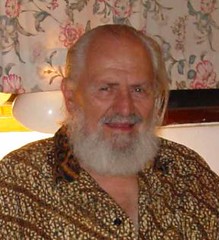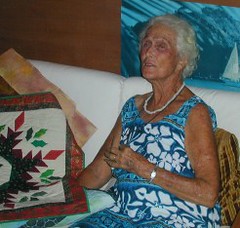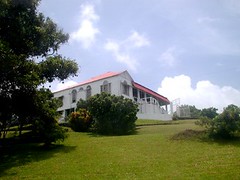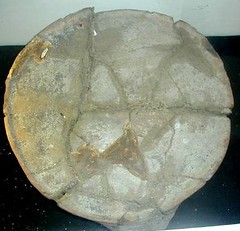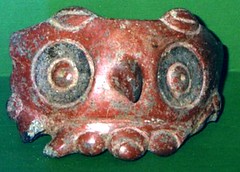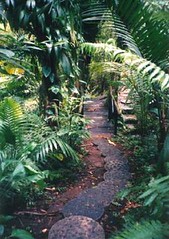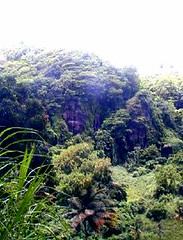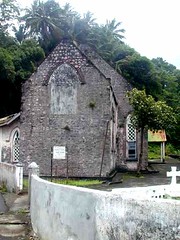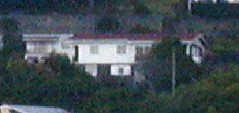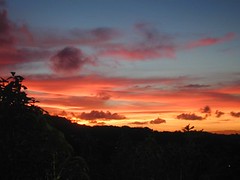Thursday, April 21, 2005
Peter's Hope

PHP5
Originally uploaded by Karlek.
Industrial ruins on the sugar estate a Peter's Hope, Saint Vincent and the Grenadines. This estate is being developed for residential and tourism, and I hope the industrial archeology site is preserved.
Petroglyph...

BAR6
Originally uploaded by Karlek.
..in the schoolyard in Barroille, Saint Vincent and the Grenadines
The PM
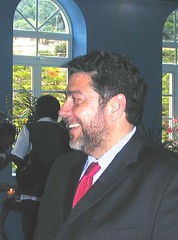
Xgonz002
Originally uploaded by Karlek.
The Hon. Dr. Ralph Gonsalves, Prime Minister of Saint Vincent and the Grenadines at an exhibit of the Horticultural Society
Me
Me
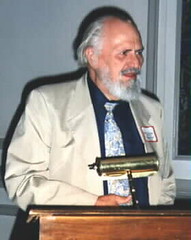
XKEpic
Originally uploaded by Karlek.
Me back when I was respectable, chairing a meeting of the Southeast [Massachusetts] Regional Planning and Economic Development District.
Vivian Child
Dominos
Farmer's Market
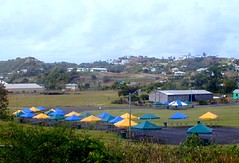
FrmMkt
Originally uploaded by Karlek.
Recently this market was set up on part of the flatlands at Diamond. Since the bulk of the price of food at the central market goes to transporters and sellers, it is possible to get some bargains here. Open Friday and Saturday mornings.
Orchid

Orchb405
Originally uploaded by Karlek.
This is the most recent orchid to come into bloom. I'll provide a reference for some other orchid pictures when I remember where they are
Editorial Note
I'm using Safari with Mac OSX and I find that I have to use the refresh button to show changes in the blog. Try that if you aren't showing up to date blogpostings.
As I get used to the blog format it is becoming more convenient to use as a general notebook. Look for more adaptations.
Other Blog
Brighton Salt Pond

BriBch1
Originally uploaded by Karlek.
Brighton Salt Pond is between Caliaqua and Rawacu. It is a bit rougher than the beaches at Villa and Indian Bay, but still swimmable.
Indian Bay Beach

IndByBch
Originally uploaded by Karlek.
Indian Bay is between the airport at Arnos Vale and Calliaqua. It has a few small hotels and a beach that is safe for children.
Wednesday, April 20, 2005
IronMan
Lizard
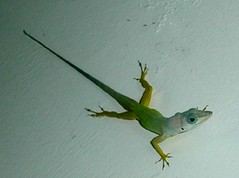
LIZZ022
Originally uploaded by Karlek.
This guy has been hanging around the bathroom. I hope he's been eating mosquitos. He's also gotten used to the flash.
The Mysterious Garifuna
When Sally and I first came to Saint Vincent and the Grenadines looking for a tropical paradise to retire to, we visited the fortress overlooking the capital city, Kingstown. There was a wonderful view of the Caribbean and the nearby grenadine island, Bequia. But something looked wrong. Normally, a fortress that was built to protect an important port like Kingstown has its guns pointing to sea to fire on an approaching fleet. But these cannons were pointing inland! They were obviously placed there to fire on people coming over land, perhaps hostile natives.
Later I found out about the Carib Wars and the way the resident Caribs kept the island relatively free of colonization from the 1500s to the late 1700s. Fort Charlotte was obviously built to protect a detachment of British troops from attacks by the natives whose lands they were enroaching on. The guns were pointed at potential attacks by those they called the Carib indians.
Still later, as I learned more about the history of St. Vincent, something else didn't fit. The British, with the military resources they had surplus after losing the American Revolution, and with German Mountain troops they had hired for the occasion, had rounded up the natives (except for a few deemed less hostile), and exiled them, first to a nearby desert island and later to Rowaton Island off what is now Honduras. They did this in 1797. There were few native people left on Saint Vincent, and those who were had no military power.
Then, after that, they built Fort Charlotte, which was finished in 1803, seven years after the natives, who we now call Garifuna, were exiled. The guns of Fort Charlotte were pointed inland, but not at the Garifuna, because they were gone. The Fort was built and the guns pointed as they were to protect the British Garrison from the ghosts of the Garifuna, the bad dreams they had of what they had done to the native people of Saint Vincent and the Grenadines.
The Garifuna, even in exile, struck fear into the heart of the British Empire.
This realization made me wonder about these mysterious Garifuna who held off the European invaders for so long. But this was only the first of the mysteries that I encountered while trying to understand the history of Saint Vincent and the Grenadines. I tried to put it together in a book on the internet (at http://svg.karleklund.net) and quickly ran into some questions. One of the first was who the Caribs were, anyway.
If you read the 17th and 18th century British sources you will find that the "Black Caribs" had practically exterminated the "Yellow" or "Red" Caribs. On the other hand if you read the French sources you will find that the people populating the island are simply Caribs, although there are a small number of people referred to as "Black Caribs" who act like other Caribs, pretty much, but have some African characteristics in their ancestry. They are harder to get along with but are useful allies in war.
Over the last forty years I have been doing research on social evolution and in the web book titled "Einstein's God and the Science of Zen" (at http://eingod.karleklund.net) I have shown that the characteristics of appearance we call "racial" evolved in the late paleolithic when we had to maintain a stable tribal population by infanticide. In earlier periods we fissioned and migrated but eventually we saturated the living space.
To limit our population we had to use birth control. The only way we could distringuish one of "us" from a "monster birth" (like Oedipus) was by what the baby looked like. If it looked like "us" that was fine, if it didn't then it was a monster not fit to live. So we evolved into a species that had a tremendous variety of appearance globally and remarkable similarity of appearance locally; and a deep suspicion of anyone who didn't look like "us". That local similarity of appearance is how we identify "race".
To the eyes of the european invaders there was an obvious strain of African appearance among the residents of St. Vincent. Whether this came from the wreck of a slaver in the 1600s or an expedition from Mali in the 1300s is something for the scholars to argue about. Certainly the european visitors, like the paleolithic shamans, had nothing to go on but appearance since they agreed that all the islanders behaved in much the same way. So we are left with motivations to resolve the mystery of the British being unable to see the Caribs that the French did..
The British were in St. Vincent to grow sugar with the aid of slaves from Africa, so if there were people who acted like Caribs but had a complexion much darker than the British did they were obviously escaped slaves who needed to be restored to their proper place. They tended to see more "Black Caribs" than "Yellow" Caribs.
The French had a different bias. They were not particularly sympathetic with the local people: they could easily exile all the locals like they did in Martinique. But they wanted the people living in St. Vincent to help them harass the British so that the French could eventually take over the British posessions in the Caribbean. The colonists they sent in did what the voyagers did in Canada, they did what farming and trapping they needed to do to survive and in many ways adapted the local customs that worked, including taking local wives. Being less racist they tended to see just "Caribs", with maybe a small proportion of "Black Caribs" who didn't like the French any more than they like the British.
Since we are not likely to be able to view photographs or DNA scans of individuals living on St. Vincent in the 18th century, it makes little sense for us to make fine distinctions between "Caribs" and "Black Caribs", especially since they differed only in appearance. So I'll refer to the native residents of Saint Vincent as "Caribs" and the people who were exiled in 1797, and their descendants, as "Garifuna", and not worry about what they looked like.
The major mystery was why the Caribs maintained a viable society late in the 18th century when the Taino vanished as a society in places like Hispanola and Cuba much earlier. The short answer is that the Caribs had worked out a solution to the problem of the mesolithic-neolithic transition that was able to use European technology without being affected by European ideology.
The Neolithic Revolution that we read about is a phenomenon that is associated with the transition from a hunter-gatherer economy structured by conformity and consensus, and a grain-growing economy structured by a central ideology and authoritarian government. The normal model developed in the plains of the mideast and spread out from there. Somilar societies developed in mainland America and among the Taino on the big islands in the Antilles.
The mesolithic-neolithic transition could cause radical changes because of the higher population densities permitted by agriculture. In northwest Europe, for instance, as soon as grain agriculture was introduced the population stopped eating fish and wild game. This made the normal children suceptible to vitamin D deficiency and bone disease. Only those children with noticeable melanin-deficiency got enough of the weak European sunlight to survive, so the melanin-concentration of the people within a few hundred miles of the North and Baltic Seas took on a paleskinned melanin-deficient appearance.
That is similar to the development of the sickle-cell trait in mosquito prone areas, so that people with a single gene for sickle-cell are immune to malaria while a person with both has sickle-cell disease. People whose ancestors came from North Europe have melanin-deficiency that allows them to survive on a grain-based diet in the north, but are suceptible to sunburn and skin cancers in the tropics.
There are also social adaptations to the transition. In the temperate rain forest of northwest America there is an area that has immense supplies of fish, wild game and berries. A tribal society using late paleolithic technology can produce much more food and fish-oil than it needs, so the society developed the practice of potlatch, whereby a tribe gave away its surplus for prestige. This amounted to a redistribution that provided a less lucky tribe with survival at the cost of a little prestige, and evened out the situations of tribes that were, for instance, berry-rich and fish-oil poor. This society lasted until the late 19th century, thousands of years after the mesolithic-neolithic transition elsewhere. It only collapsed when a commercial market for beaver skins paid for in manufactured goods completely unbalanced their redistribution system.
In the 16th century Caribbean the Taino on the big islands had gone through the transition to grain agriculture, a central religion and a hierarchical society and were suceptible to invasion from a society that had those qualities plus better technology. Their society collapsed under the domination of the spanish colonists.
The Caribs, on the other hand, resisted. In particular, the Caribs on St. Vincent had developed a solution that maintained the vigor of a late paleolithic hunter-gatherer society and that was able to use European technology without being suceptible to Neolithic-style ideology. This appears to be a unique social development.
Luckily we have a contemporary observer Rev. Fr. Adrien Le Breton, S.J.(1662-1736) whose manuscript "Historic Account of Saint Vincent, The Indian Youroumayn, the island of the Karaybes" was translated and published in 1998 by the Mayereau Environmental Development Organization.
The Caribs of St. Vincent, as described by Fr. Le Breton from personal experience, are "perfectly equal, and they recognize absolutely no official, chief or magistrate." This is characteristic of the hunter-gatherer stage of social evolution and normally is limited to groups of the order of a dozen in size who operate by a combination of conformity and individuality. This is generally found at a population density of about a square kilometer per person in open country.
However, Le Breton also says "...the fortunate complicity of the country astonishingly encourages the people's frenzy for total independence. ...the island ... is riddled with bays and hollows ...[and].. offers each father of a family the opportunity to choose ...his ideal site. far from any foreign constraint and completely safe ... to lead his life exactly as he pleases."
In other words, the Caribs of St. Vincent took advantage of the geography to settle in small communities that were relatively isolated from one another and so avoided the crisis of size that determined the population dynamics of the hunter-gatherer band in open country. The conflicting needs of conformity and individuality made the band fission at about a dozen members. The constraint of the barriers between settlements made possible a population density an order of magnitude larger than elsewhere. This made it possible for the Caribs to practice limited slash-and-burn agriculture and use ceramic technology while avoiding the hierarchical structure of the people on larger islands.
The other characteristic that Fr. Le Breton describes is that they "visit one another as frequently as possible". This again is unique to the Caribs of St. Vincent, but it allowed them to maintain a uniform island-wide culture while maintaining the egalitarian and antiauthroritarian values that were their characteristic and that Fr. Le Breton found so unusual.
At the same time it also gave them the ability to absorb technology from the Europeans without losing their own culture. They not only quickly adopted iron tools and weapons, but, as described by Moreau de Jonnes from his own experience, when there were food shortages on St. Vincent they felt free to go to Trinidad in a pirogue, hire schooners there that were more suitable to transport bulk cargo bought with salvaged spanish coinage. In other words rather than being "savages" they were perfectly capable of operating in a european-style money-based economy. They simply chose not to.
This suggests that the Caribs were somewhat like the Vikings: they built vessels capable of going from the Orinoco to the Bahamas, trading where appropriate and raiding where that was possible. Like the Vikings they were regarded as a menace in the settled agricultural communities of the big islands, so that the Taino told Columbus that they were cannibals, much the way the early English described the Vikings as monsters.
Whether or not they practiced a ritual consumption of relatives like the Mali, or the symbolic consumption of Jesus' body and blood in the Roman Mass, is probably not resolveable now; but they were certainly independent and individualistic enough to horrify a hierarchical society.
If they were like Vikings it would explain the mystery of language in that the men and women seemed to speak different languages. The women of a Carib community would speak the normal Amarak that would be spoken in the family, while the men would speak to a stranger in the Carib that served as a trading pidgen, or creole, within the Caribbean basin.
This would also explain their attitudes toward the Africans, French and British who came to St. Vincent. Whether the Africans came from Mali in the 1300s or were survivors of shipwreaks or escaped slaves after the 1500s they would not have been trying to expel the Caribs and replace their culture with a different one. The French were less welcome but less disturbing to Carib values than the British; so while the Caribs did what they could to play the British and French off against one another, they were generally more tolerant of the French. That is what makes French sources generally more useful.
In a sense solving these mysteries can be considered academic. It may be asked what difference it makes today. But there are some questions that are of contemporary interest.
Sally and I ended up in St. Vincent after stays on other Caribbean Islands. We had made week-long visits to St. Kits, Nevis, Antigua, Martinique, Guadaloupe, ans Grenada, and shorter visits to Puerto Rico and Trinidad. We visited St. Vincent for a week, came back the next winter for two weeks, and came back some months later and bought a house. We have spent winters in that house for the last ten years.
We fell in love not only with the island, as I describe in the web-book (at Http://svg.karleklund.net), but with the people who seemed to be friendlier than anywhere else in the Caribbean we had been. Comments with the same intent have been heard off and on during the last decade, and we have heard from people in the tourist industry that people from other islands come to St. Vincent for a vacation.
There is historic evidence that is consistent with this: Grenada is an island similar to St. Vincent but with a different history. From the post-colonial government to the present Grenada has had two violent revolutions and an international war. St. Vincent has had a couple of strikes and some peaceful elections.
There are some islands where if a melanin-deficient person like myself goes down the wrong street you can cut the tension with a knife; I have had "Honkey, go home" shouted at my car once. and that was with a New York accent. (I was born in New York City so I know that accent well.)
It would be impossible to say that the friendliness evolves directly from the hospitality of the Vincentian Caribs, but they are both characteristic of St. Vincent and not common elsewhere.
I had my attention drawn to the History of St. Vincent and the Garifuna by Professor Hilary Beckles of UWI Cave Hill in Barbados. Professor Beckles had represented both Barbados and St. Vincent at the UN conference on Racism at Durban, South Africa and said, among other things, that just as St. Vincent was at the center of the world in 1795 it was also there at the present. That led me not only to study the history of St. Vincent but to look at the future of racism.
Even an extreme economic conservative like President Bush speaks of spreading democracy around the world, so it is not unreasonable to believe that the next stage in human social evolution will involve an infrastructure that assumes a global egalitarianism. On the other hand it is clear that the developed nations are characterized by a conspicuous display of resource use as a status symbol. In fact so much resources are wasted on status display that there wouldn't be enough if everyone used resources at that rate.
There is no significant ideology that says that people of any particular ethnicity deserve to waste resources that other people need to survive, so there are only two solutions to this situation:
1. The people of the developed nations (i.e., Western Civilization) will have to adopt a lifestyle that can be shared with all the other people of the globe (i.e. economic egalitarianism), or:
2. The establishment of Western Civilization will have to maintain or increase the level of poverty by force.
The policy of the Bush Administration in the U.S. is to redistribute wealth from the poor to the rich, and, as Prof. Beckles reported from Durham, the establishment of Western Civilization doesn't even want to discuss questions of equity such as reparations for slavery, so it is unlikely that the first solution will be adopted any time soon.
The implication is that the force by which Western Civilization will use to maintain economic inequity will have to be answered by force. The conflict between American policy and the Muslim Jehad in Iraq follows the example of the Jehad against Russian puppet governments in Afghanistan in showing that an ideologically based insurrection can cost a large nation so much that conquest is not worth the effort. Unfortunately it destroys what it attempts to save.
What the undeveloped world needs is a movement that is not ideological in the sense of being nationalistic, is ecumenical with regard to religion, is not violent for violence's sake as nihilism can be, and has the power to survive under difficult circumstances.
Common sense would say that that is impossible, except that the Garifuna have managed to provide an example. The Garifuna survived a serious attempt at genocide by the British Empire, they exist as Garifuna in several nations, they can be religious without losing the sense of being Garifuna, and they can, with the support and encouragement of their fellows, escape the status competition that rules most of Western Civilization.
Perhaps most importantly at this crisis-point in evolution they have no attraction to racism. The Garifuna trace their roots to both Africa and the Caribbean basin, but their genetic makeup is likely to run from almost pure African to almost pure Carib with traces of genes from Europe and Asia. The conflict between Westerners (i.e.. Melanin-deficient Northern Europeans and their American descendants) and everyone else may be basically economic, but it is easier to see a pale skin than an economic theory when peering through the sights of a rifle.
So what we need in this crisis is for a group like the Garifuna (if there are any other groups like the Garifuna) to come to terms with its identity and the role it can play in the evolution of the human species.
Accidentally, there is an opportunity to do just that. Disney has followed up its popular "Pirates of the Caribbean: The Black Pearl" with "Pirates of the Caribbean: Dead Man's Chest". This will feature the Carib Indians as slapstick clowns playing at being cannnibals, comic figures like the roles in which they cast African-Americans (or Americans in blackface) during the 1920s and 30s. The Disney producers probably thought that the Caribs were exterminated and that no one would be alive to complain. When the Caribs of Domenica and St. Vincent complained the executives in Hollywood were indifferent because the complaints only ocurred in local media and nobody important knew who the Garifuna were.
This will provide an opportunity for telling the other media in Western Civilization that there are people who find this offensive, and reminding Disney that it has already invested in a second sequel that doesn't need adverse reviews even before it opens. Whether or not we can convince Disney to eschew racism, we can still make "Garifuna" a more common word in the lexicon of ethnic politics.
Karl Eklund, Ph.D.
Villa, Saint Vincent and the Grenadines
April 7, 2005
Original prepared for the Garifuna website at www.labuga.com
Botanical Garden

BOTGD001
Originally uploaded by Karlek.
Path to Government House, the official residence of the Governor General.
Botanical Garden
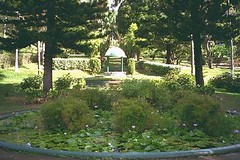
BOTGD002
Originally uploaded by Karlek.
Lily pond and gazebo in the Botanical Garden, Kingstown, Saint Vincent and the Grenadines. This is the oldest botanical garden in the americas, and has been continuously operated since the 1700s. Its breadfruit tree is grown from a slip brought by Capt. Bligh on his second voyage (after the famous mutiny).
Orange Hill
Orange Hill
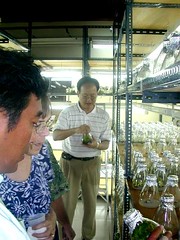
OH07
Originally uploaded by Karlek.
Tissue culture laboratory of the ROC (Taiwan) Agricultural Project, located at the Orange Hill Plantation
Orange Hill Plantation
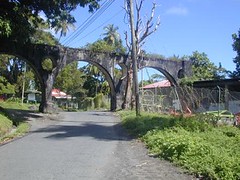
OH11
Originally uploaded by Karlek.
Remains of aquaduct at the Orange Hill Plantation, where it once ran a sugar mill.
Chatoyer Monument

60CHAT
Originally uploaded by Karlek.
A monument erected in honor of Chatoyer, a Garifuna War-Chief and General of the Armies of France, and National Hero of Saint Vincent and the Grenadines. The monument is erected on Dorsetshire Hill, above Kingstown, on the spot where he was killed in the Second Carib War in 1795.
POT3
BIRD2
BIRD1
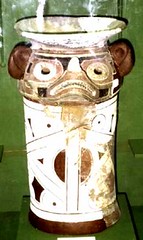
BIRD1
Originally uploaded by Karlek.
Bird effigy from the Kirby collection, reconstructed from fragments.
MONT19
YAMB03
MESPO04
02HSE02

02HSE02
Originally uploaded by Karlek.
Our house from the street above. Conroy's apartment is what you see.
02HSE01
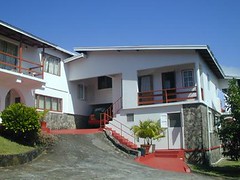
02HSE01
Originally uploaded by Karlek.
Our house, from the parking area. As you can see. I park in the breezeway
01HSE03
PubLib

PubLib
Originally uploaded by Karlek.
Temporary housing for the public library. They are supposed to build something behind the Peace Memorial Building to house the library and the museum.
PaulStNew

PaulStNew
Originally uploaded by Karlek.
They removed all the shacks with food and rum shops. I haven't found them yet.
KingHbr
Eastern Caribbean Dollar (Reverse)
Eastern Caribbean Dollar

ECDO
Originally uploaded by Karlek.
These are versions of the "EeeCee" dollar currently in circulation. The oldest, on the left, is bronze. The octagonal version in the center is still very common but the new version on the right probably bounces better in a slot machine. The next picture shows the reverse.
Shirley Jones
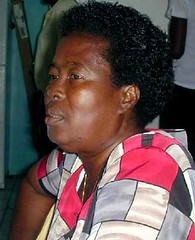
BBQ10
Originally uploaded by Karlek.
Shirley is the manager of the Paradise Inn in Villa, Saint Vincent and the Grenadines, and is building her own hotel, The Oasis, in Argyle.
She is the main reason we now live in Saint Vincent and the Grenadines for most of the year.
RedAngel

RedAngel
Originally uploaded by Karlek.
This can be seen in the Anglican Cathedral in Kingstown, Saint Vincent and the Grenadines. It was comissioned by Queen Victoria to honor one of her children, but when she saw that the angel was not dressed in white she was not amused. It sat in a storeroom for a while and was then given to St. Vincent the way you might give unfashionable clothing to a poor relation. St. Vincent made a virtue of what might have been a snub. You should go look at it when you visit Saint Vincent and the Grenadines.
About this Blog
Remember also that there is a version of the Introduction To Saint Vincent and the Grenadines on the web at http://svg.karleklund.net. I'm updating that, including working in some of the photos shown on this blog.
You can find other sites in the index page at http://karleklund.net
Feel free to drop me a note at webmaster@karleklund.net
Monday, April 18, 2005
Rainy Friday

MARK0004
Originally uploaded by Karlek.
You get charged for using spaces in the New Market Building itself, so some people prefer to take their chances on the sidewalk outside. On a rainy day it isn't nice.
At A Barbecue

DSCN0004
Originally uploaded by Karlek.
Sally and Dr. Shiela Penington, the eminent psychologist, at the Paradise Inn at Villa, Saint Vincent and the Grenadines
Tropical Dawn
Sally-MrKo
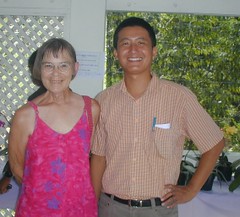
Sally-MrKo
Originally uploaded by Karlek.
Sally & Mr. Ko, the ROC (Taiwan) orchid expert, at the exhibit at the ROC Embassy in Kingstown, Saint Vincent and the Grenadines
Sally-Karl

Sally-Karl
Originally uploaded by Karlek.
Sally & Karl at the Republic of China (Taiwan) embassy for the Orchid Exhibit. Some of Sally's orchids have been chosen for cloning by tissue culture in their program.
